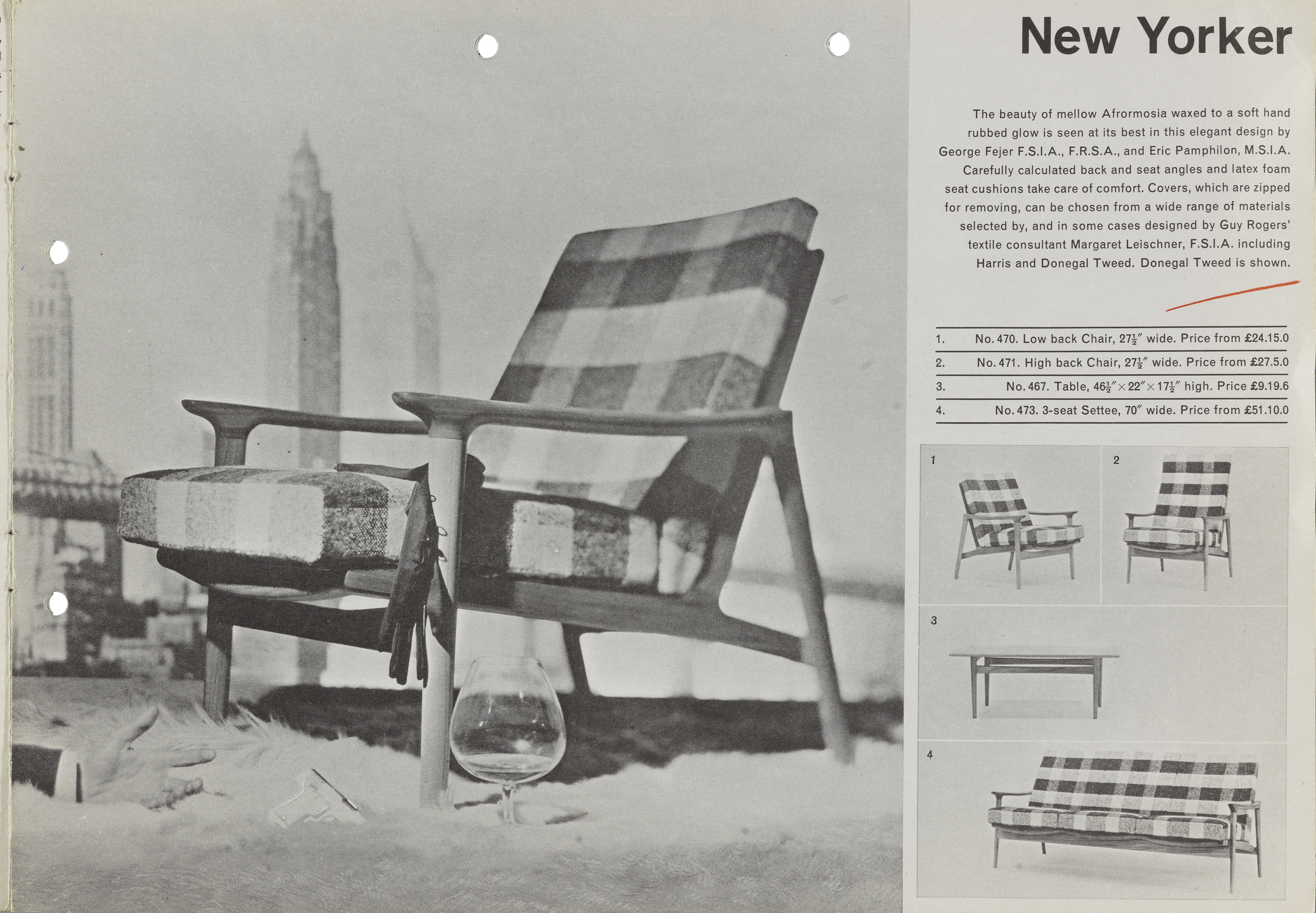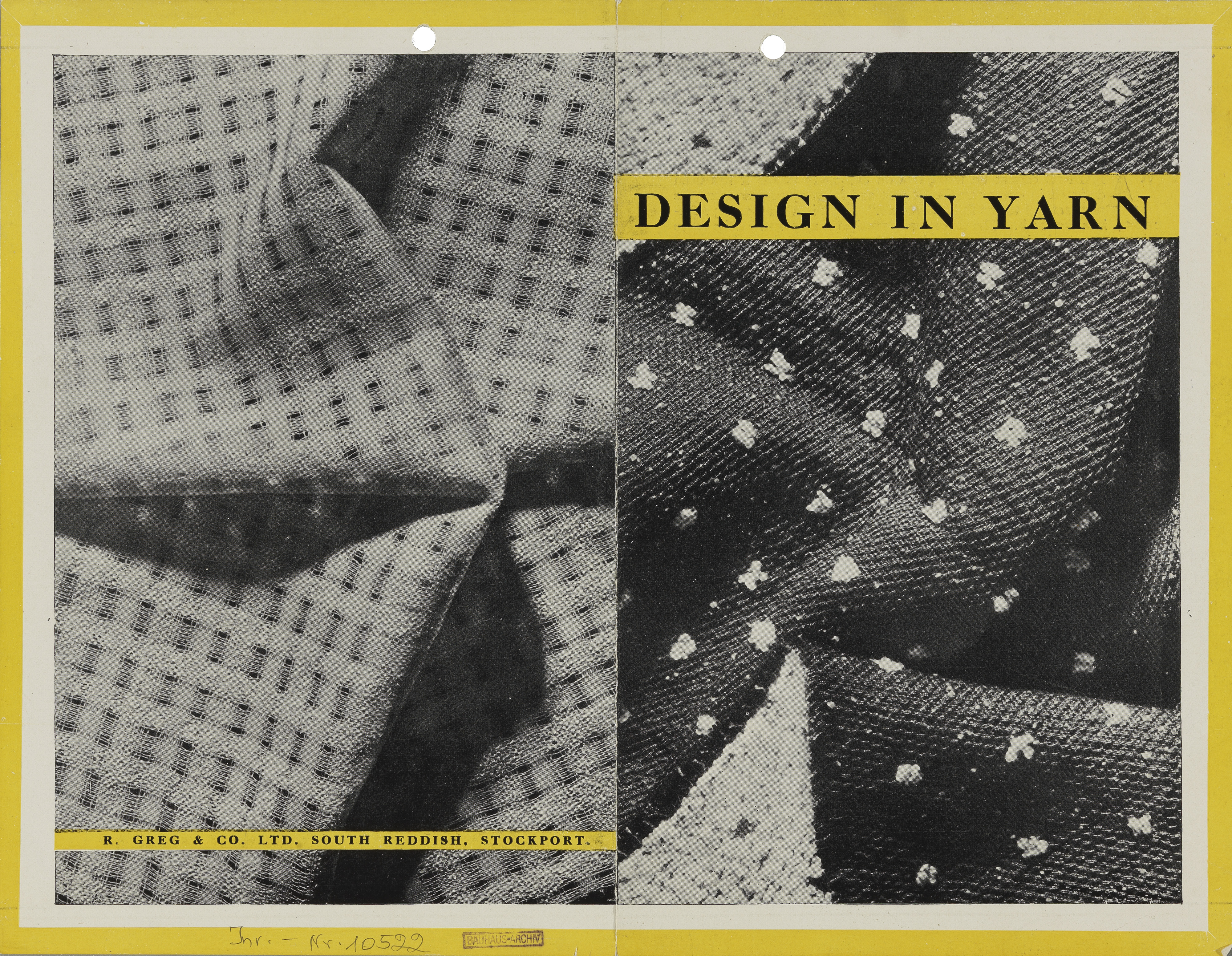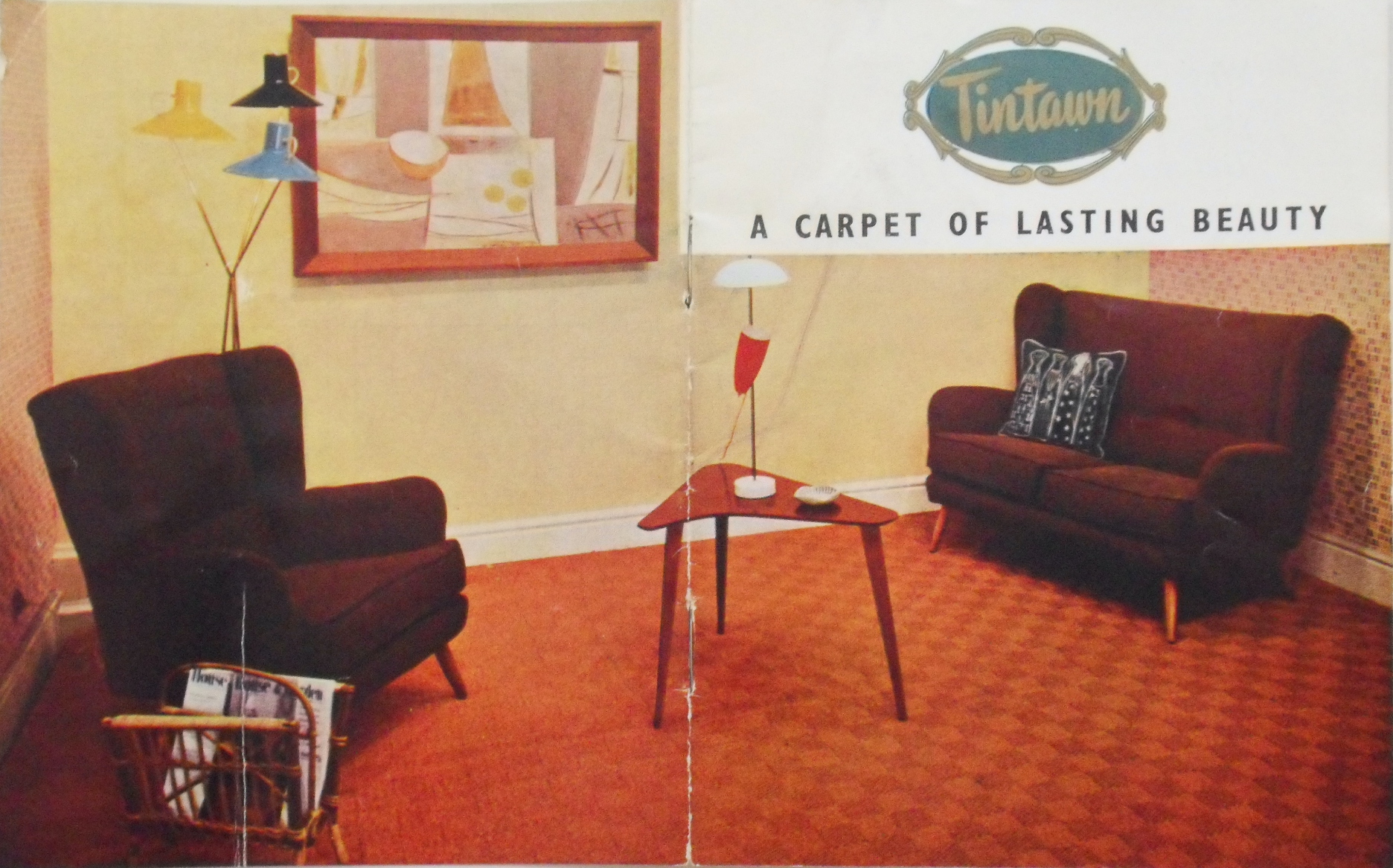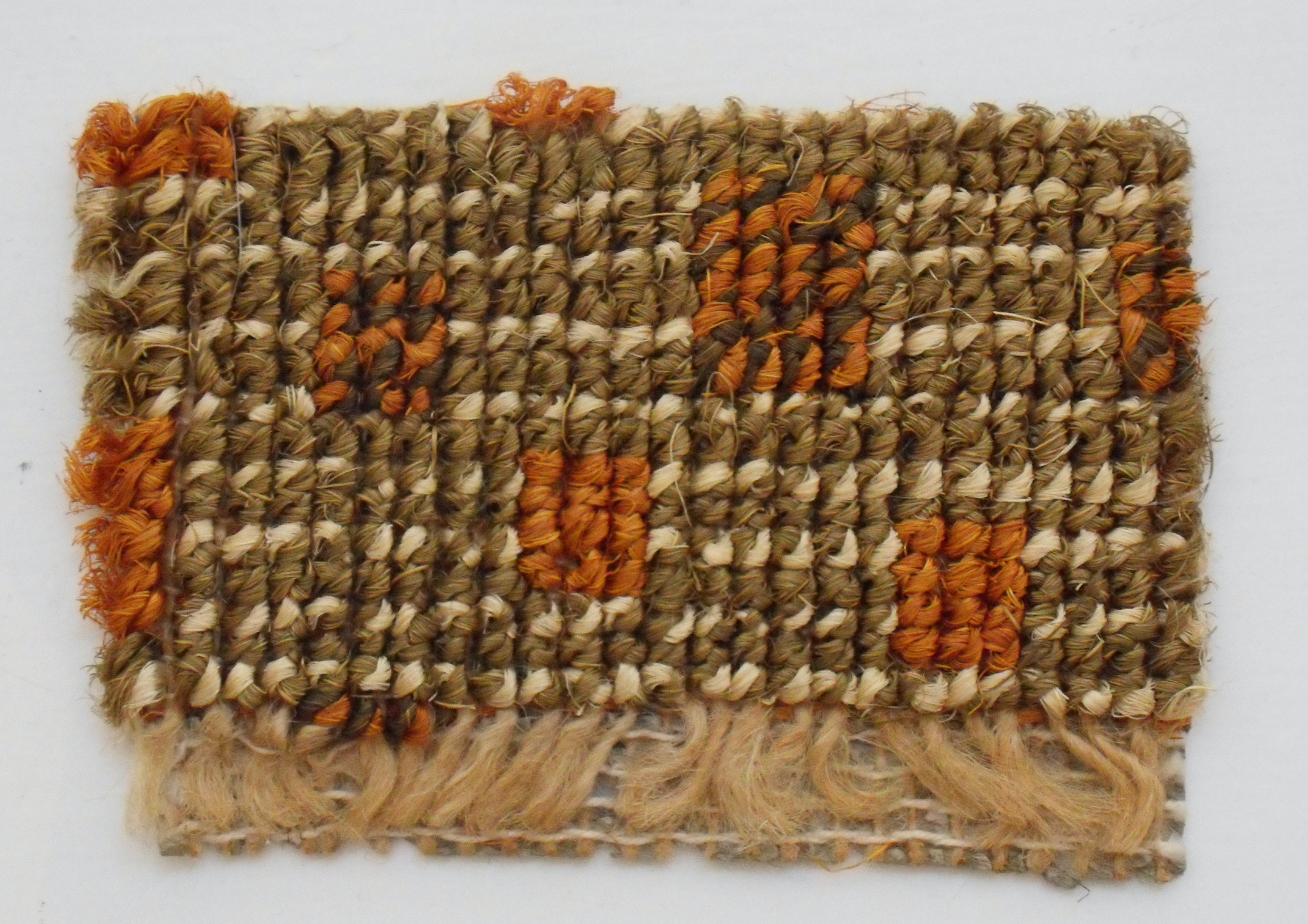Archive
Margaret Leischner
- Margaret
- Leischner
Frida Margarete Leischner
- 15-04-1907
- Bischofswerda (DE)
- 18-05-1970
- Maplehurst (GB)
- Textile Designer
The designer Margaret Leischner lived in England from 1938, worked for textile and furniture companies, taught at the Royal College of Art and was honoured as Royal Designer for Industry.
Word Count: 29

Tintawn Carpets brochure featuring designs by Margaret Leischner (Bauhaus-Archiv Berlin, Margaret Leischner Papers, Folder 6, Inv. No. 7568). 
Margaret Leischner, Advertisement for BOAC (British Overseas Airways Corporation), seat fabrics, 1955 (Bauhaus-Archiv Berlin, Margaret Leischner Papers, Folder 12, Inv. No. 75693). 
Brochure: “Choose comfort with Guy Rogers for 1963” featuring Leischner’s fabric for the ‘New Yorker’ upholstered furniture series (Bauhaus-Archiv Berlin, Margaret Leischner Papers, Folder 6, Inv. No. 10523). 
Company brochure: “Design in Yarn”, R. Greg & Co. Ltd. South Reddish, Stockport (Bauhaus-Archiv Berlin, Margaret Leischner Papers, Folder 6, Inv. No. 10522). 
Tintawn Carpets brochure (Eileen Ellis, Photo: Burcu Dogramaci, 2011). 
Margaret Leischner, Sisal sample Tintawn Carpets, 1960s (Eileen Ellis, Photo: Burcu Dogramaci, 2011). 
Margaret Leischner obituary, by Donald Tomlinson, Design Journal, vol. 5, no. 259, 1970, p. 83 (Photo: Private Archive). Anonymous. Tintawn Carpets. Margaret Leischner Papers (broshure, Bauhaus-Archiv Berlin, n.d.), Folder 6, Inv. No. 7568.
Conlan, Frank. “Margaret Leischner (1907– 1970) – A Bauhaus Designer in Newbridge, Co. Kildare.” Creative Influences. Selected Irish-German Biographies (Irish-German Studies, 4), edited by Joachim Fischer and Gisela Holfter, Wvt Wissenschaftlicher Verlag Trier, 2009, pp. 99–108.
Das Bauhaus webt. Die Textilwerkstatt am Bauhaus, edited by Magdalena Droste and Manfred Ludewig, exh. cat. Stiftung Bauhaus Dessau, Dessau, 1998.
Dogramaci, Burcu. “Bauhaus-Transfer. Die Textildesignerin Margaret Leischner (1907–1970) in Dessau und im britischen Exil.” Entfernt. Frauen des Bauhauses während der NS-Zeit – Verfolgung und Exil, edited by Inge Hansen-Schaberg et al., edition text + kritik, 2012, pp. 95–116.
Dogramaci, Burcu. “Margarete Leischner.” Frauen am Bauhaus. Wegweisende Künstlerinnen der Moderne, edited by Patrick Rössler and Elizabeth Otto, translated by Birgit van der Avoort, Knesebeck 2019, pp. 108–109.
Hurle, Ruth. “Miss Leischner and the Bauhaus.” Quarterly Journal of the Guilds of Weavers, Spinners and Dyers, vol. 19, no. 79, 1971, pp. 1476–1478.
Leischner, Margaret. Letter from Germany (typed report, Bauhaus-Archiv Berlin, n.d. [1946]).
Leischner, Margaret. “Das Bauhaus. By Hans M. Wingler (review).” Journal of the Royal Society of Arts, vol. 111, no. 5086, September 1963, pp. 847–848. JSTOR, www.jstor.org/stable/41367457. Accessed 7 March 2021.
Leischner, Margaret. “Furniture in Britain to-day. By Dennis and Barbara Young (review).” Journal of the Royal Society of Arts, vol. 113, no. 5107, June 1965, p. 545. JSTOR, www.jstor.org/stable/41369518. Accessed 7 March 2021.
Leischner, Margaret. “On Design.” Textiles of Ireland, no. 1, 1966, offprint, n.p. (Bauhaus-Archiv/Museum für Gestaltung, Berlin).
Leischner, Margaret. “Design Management. By Michael Farr (review).” Journal of the Royal Society of Arts, vol. 115, no. 5131, June 1967, pp. 569–570. JSTOR, www.jstor.org/stable/41371625. Accessed 7 March 2021.
Leischner, Margaret. “The Bauhaus a legend?.” Journal of the Royal Society of Arts, vol. 116, no. 5148, November 1968, pp. 1048–1049. JSTOR, www.jstor.org/stable/41370242. Accessed 7 March 2021.
Leischner, Margaret. “Principles of Neo-Plastic Art by Theo van Doesborg, Painting, Photography, Film by Laszlo Moholy-Nagy, Graphic Works from the Bauhaus by H. M. Wingler, Gerald Onn (review).” Journal of the Royal Society of Arts, vol. 118, no. 5161, December 1969, pp. 48–49. JSTOR, www.jstor.org/stable/41372032. Accessed 7 March 2021.
Maguire, Patrick J., and Jonathan Woodham, editors. Design and Cultural Politics in Postwar Britain: The Britain Can Make It Exhibition of 1946. Leicester University Press, 1997.
Nyburg, Anna. “Textile in Exile: Refugee Textile Surface Designers in Britain.” Applied Arts in British Exile from 1933. Changing Visual and Material Culture (The Yearbook of the Research Centre for German and Austrian Exile Studies, 19), edited by Marian Malet et al., Brill/Rodopi, 2019, pp. 212–228.
Pevsner, Nikolaus, et al. Geheimreport Deutsches Design. Deutsche Konsumgüter im Visier des britischen Council of Industrial Design (1946) (Deutsches Museum, Abhandlungen und Berichte, Neue Folge, 28), edited by Anne Sudrow, Wallstein, 2012.
Read, Herbert. Letter to Margaret Leischner. Margaret Leischner Papers (Bauhaus-Archiv Berlin, 5 December 1944).
Sudrow, Anne. “Der ‘Moderne’ auf der Spur. Das deutsche Design als Zielobjekt des britischen Geheimdienstes BIOS in der frühen Nachkriegszeit.” Pevsner, Nikolaus, et al. Geheimreport Deutsches Design. Deutsche Konsumgüter im Visier des britischen Council of Industrial Design (1946) (Deutsches Museum, Abhandlungen und Berichte, Neue Folge, 28), edited by Anne Sudrow, Wallstein, 2012, pp. 11–105.
Tomlinson, Donald. “Obituary. Margaret Leischner.” Design Journal, vol. 5, no. 259, 1970, p. 83.
Wortmann-Weltge, Sigrid. Bauhaus-Textilien. Kunst und Künstlerinnen der Webwerkstatt. Edition Stemmle, 1993.
Word Count: 509
Bauhaus-Archiv/Museum für Gestaltung, Berlin.
Word Count: 6
My deepest thanks go to Eileen Ellis, Marian Malet and Joe McCabe.
Word Count: 12
GB (1938–1970).
Royal Society of Arts, 8 John Adam Street, Westminster, London WC2 (member as Royal Designer for Industry, 1969).
- London
- Burcu Dogramaci. "Margaret Leischner." METROMOD Archive, 2021, https://archive.metromod.net/viewer.p/69/1470/object/5138-11259964, last modified: 21-06-2021.
-
Hans SchlegerGraphic DesignerLondon
Some of the most important work of Hans Schleger was created for London Transport. He relaunched London Transport bus stop signs and was responsible for a series of Blackout posters.
Word Count: 30
Herbert ReadArt HistorianArt CriticPoetLondonThe British art historian Herbert Read established himself as a central figure in the London artistic scene in the 1930s and was one of the outstanding supporters of exiled artists.
Word Count: 30
Visual Pleasures from Everyday ThingsBookletLondonVisual Pleasures from Everyday Things is a booklet written in 1946 by the emigrated architectural historian Nikolaus Pevsner with the aim of aesthetic education and teacher training.
Word Count: 26
László Moholy-NagyPhotographerGraphic DesignerPainterSculptorLondonLászló Moholy-Nagy emigrated to London in 1935, where he worked in close contact with the local avantgarde and was commissioned for window display decoration, photo books, advertising and film work.
Word Count: 30
Andreas FeiningerPhotographerWriterEditorNew YorkAndreas Feininger, was a German émigré photographer who arrived in New York with his wife Wysse Feininger in 1939. He started a lifelong career exploring the city's streets, working as a photojournalist and writing a large number of photography manuals.
Word Count: 39
Otti BergerTextile DesignerWeaverLondonThe textile designer and weaver Otti Berger lived in exile in London in 1937/38, where she sought to open up a new field of activity.
Word Count: 24
T. Lux FeiningerPhotographerPainterNew YorkLux T. Feininger was a German-American émigré photographer and painter and the brother of the photographer Andreas Feininger, arriving in 1936 in New York. Although he started taking photographs during the 1920s in Germany, Feininger is better known for his career as a painter and his photographic work is largely unacknowledged.
Word Count: 50
A Hundred Years of Photography 1839–1939BookLondonSix years after her arrival in London, the photographer Lucia Moholy published her book A Hundred Years of Photography 1839–1939, on the occasion of the centenary of photography.
Word Count: 27